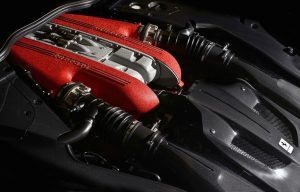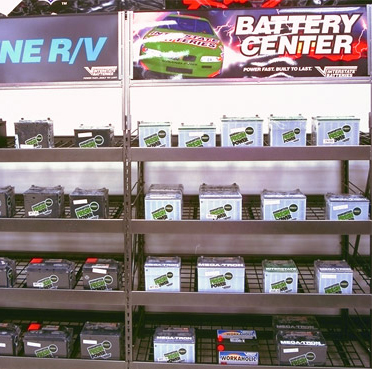What makes a fast car appealing?
It’s not just that it’s fast. It’s equally other things, such as what makes it fast – the mechanical erogenous zone under its hood. Which is unique to it, unlike the others.
A Porsche and a Ferrari are both very fast – but they are fast in very different ways. The Porsche has a flat six perched over its rear wheels. The Ferrari, a mid-mounted (and upright) V12. Even if they both turned in identical 0-60, quarter mile and top speed timeslips, the experience each car gives you is distinctly individual. A Porsche feels – and sounds – like a Porsche.
A Ferrari feels – and sounds – like a Ferrari.
Not a Porsche.
It is not so much a question of better or worse but of meaningful differences, just as a Frank Lloyd Wright house is a very different kind of house than a Phillip Johnson house.
What if all houses were exactly the same?
In some places, they already are – and it’s depressing. Box after box after box, like GMO corn in a field.
What if all cars were the same?
What if there were no longer any meaningful difference between a Porsche and a Ferrari – and a Camry? What if they all were fundamentally the same things under their skins? If the internal combustion engine is forced into retirement in favor of electric drive, that is exactly what they will be like.
Battery packs and electric motors differ mainly in their size and power output. One is 75 kWH while another is 100 kWH. That’s nearly as exciting as the difference between a six pack of generic brand cola and a twelve pack of the same stuff.
When it comes to electrically-powered cars, there’s nothing analogous to the differences in kind between a Porsche’s flat six and a Ferrari’s V12.
Or a Camry’s V6, for that matter.
Just look under the hood. Even visually, the differences are as obvious as the differences between a Frank Lloyd Wright house and a Phillip Johnson house.
And it is these differences which give each car its distinctive personality and give us a reason to buy one vs. another. These reasons may be entirely subjective. It might be the sound of the Porsche’s flat six vs. the Ferrari’s V12. People have been known to fall in love with a car before they have even driven it – just by hearing it.
How many of us instantly recognize the sound of an old VW Beetle? And smile when we hear it? Its air-cooled flat four sounds like no other engine. Part of the charm of the car was exactly that – and many other similar things which were uniquely old Beetle. The new one merely looks like the old one. Which explains why it’s not as iconic – as beloved – as the original.
It is just another car.
Electric cars will triple-down on this tendency toward vehicular homogenization. They are fundamentally generic. Modules. Shells in various colors and shapes.
Other than how quickly it gets to 60, a Tesla and a Nissan Leaf are essentially – functionally – identical. Or at least, not much different. There is an electric motor and a battery. The specifications of the motor and vary vary, but they are fundamentally the same things. Just as the 12V starter battery (and electric starter motor) in your current IC car are fundamentally the same things.
Is there any romance – or even feeling – when it comes to Diehard vs. Exide?
Granted, this may not matter much to people who buy cars as appliances. But what about people who buy Porsches and Ferraris?
The intangibles – the differences – do matter to them. And for the same reason that they matters to people who appreciate a Frank Lloyd Wright house – or prefer a Phillip Johnson house.
Electrification will be The End for brands like Porsche and Ferrari – if they are foolish enough to bite the hook baited for them by Tesla. For in that case, there will no longer be a Porsche – or a Ferrari – in any meaningful sense.
They will be badges on shells of different shapes.
Speed matters, certainly. It is one of the reasons people by Porsches and Ferraris. But it is far from the only reason. If these icons are electrified, why would anyone buy one or the other – rather than a Tesla? What happens when every exotic car can get to 60 in the same 2.8 seconds using essentially the same battery/electric motor? Will anyone care about Porsche or Ferrari anymore?
Will those brands mean anything substantive? How?
Think about an electric car race. A pack of battery-powered widgits whipping silently around an oval. The drivers better have outsized personalities to compensate for the anodyne machinery.
DieHard vs. Exide.
. . .
Got a question about cars – or anything else? Click on the “ask Eric” link and send ’em in!
If you like what you’ve found here, please consider supporting EPautos.
We depend on you to keep the wheels turning!
Our donate button is here.
If you prefer not to use PayPal, our mailing address is:
EPautos
721 Hummingbird Lane SE
Copper Hill, VA 24079
PS: EPautos magnets are free to those who send in $20 or more. My latest eBook is also available for your favorite price – free! Click here. If you find it useful, consider contributing a couple of bucks! 













Eric’s comment illustrate perfectly the reasons I dislike Formula E. Like watching vacuum cleaners go ’round and ’round. Wow, really exciting.
Who ever is deciding what regulations will be written at the EPA are in control. We’re just lying to ourselves if we think otherwise. Elections seem to just move them around a bit – like erasing a Etch-A-Sketch.
Beautiful write up Eric.
The difference is the mundane versus the art. The art of the Porsche or the Ferrari is what makes each unique and special, DaVinci versus Michelangelo, cylinders cycling up and down, metal gears meshing; the similarities are superficial, the differences deep.
This is another symptom of the PTB (Powers that be) turing us in a homogenous mass with no individual traits.
I’m glad I am old but I feel for my grandchildren.
Thanks for the kind words, Alex… I also weep for the future and do my best to corrupt as many young people as possible!
I am doing my part, I brought the grandkids to the Volksfest, they are now converted, The one 15-year-old told me that these cars had “character” and were “interesting”.
Fahrvergnügen für immer!!
Exide at one point and maybe still does made die hard batteries. There are only a few car battery manufacturers. Others are just brands that may or may not specify batteries that are different from the manufacturers’ standard models.
Eventually the car market may achieve fascist economic efficiency. Just a few models made by even fewer companies. Competition is a sin they say.
Johnson Controls, or whatever the name of the company they just spun off is called, makes 1 out of every 3 batteries sold worldwide.
Okay, at the risk of being overly optimistic,
In my world, DoD or the FAA can spec everything down to the last comma. Engines, landing gear, you name it.
However, individual designers arrange things a bit differently, industrial engineers will introduce small changes to ease production. Still meets spec, but it will be a little different. Also consider different manufacturers are in competition with each other. They (hopefully) will find ways to make the driving experience different to give the marketing people something.
I think you are right Eric, and your article got me thinking. It seems that even today with ICE vehicles, it is darn near impossible to tell one from the other by the sound of the engine. Exceptions would be for the high end cars like a Porsche or a Ferrari. Companies even go so far as to “add” sound to make them more appealing. Again, except for very high end cars, they all drive more or less the same way. They are for the most part FWD with CVTs or automatics that seem more like appliances than cars. Personality in cars is long gone, and I am saddened by that fact.
There is still going to be a lot of characteristics to compete about. I for instance, think that Tesla is a nice and very fast electric car, but I never became comfortable with the computer screen in the middle of the car, and Tesla also is prohibitively expensive. I prefer to have the main information, such as speed and battery status just in front of me. Why should I turn my head to the right to check my speed?
I also tested a BMW i3, which I actually liked for its speed an acceleration, but the trunk was far too small, the road-holding compromised by too narrow tires and BMW was just a little to expensive. Therefore for now I ended up with the most boring electric car on the planet; a Leaf because of a competitive price and relatively acceptable all around qualities.
The next time I buy a car there is also going to be different characteristics to consider. Perhaps I would prefer a longer range, much more power (compared to Leaf) and a more luxurious interior. I might also consider a plug in hybrid. Thus competition never ends, even if all cars should become electric. Yet, I don’t think so because electricity is much more expensive for instance in Denmark and Germany.
By the way, in Norway it is really inexpensive to use an electric car, due to relatively inexpensive electricity. Without that, I would still be driving around in a diesel engine powered car.
Hi Jone,
I always appreciate your input – as someone who owns an electric car! On the Tesla: I think one of the reasons the company restricts test drives – to people like me – is precisely because I would notice and mention in print such things as the off-center touch screen you mentioned. Stupid design like that would get Ford or GM or Toyota mercilessly roasted by the car press..
Speaking of stupid design: Is it just me? Or do others find idiotic the new turn-signal-turns-off-marker-light thing? Every time I see that thing in action I think, poor bugger, his brandy new car already has a burned out marker light. Can it be defeated? Is that considered to be a “competitive edge” feature?
Side marker repeaters for turn signals have been required in much of the rest of the world for a very long time. In the USA they are allowed but not required.
Side marker repeaters are useful and beneficial if done correctly and turn signals are used. However having vehicle lighting done correctly seems to be rarer every year.
The reason headlamps are switched off is because the idiots started putting turn signal lamps where the headlamps blotted them out. The fix was of course done through software by turning off the headlamp instead of putting the turn signal lamp away from the headlamps or at least to the outboard side and/or setting up the beam pattern to avoid blotting it out.
It’s the difference between snails and oysters. Do you like snails? No, Master. Do you like oysters? Yes, Master, when I can get them. Is a man evil because he chooses to eat snails rather than oysters? No, Master, I don’t believe so. So you see, Antoninus, it is all just a matter of taste, wouldn’t you agree? Well, Master, when you put it like that, I suppose so.
Our government lickspittles could truly care less about this.
Amen on all of that, Tallpine!
I have come to almost dread getting a fast new car to test drive… for exactly those reasons. I also always yield to faster-moving traffic, regardless of my own speed!
In fact the government folks WANT the boring standardization. Makes it easier to regulate.
Social engineering in the USA is driven by the same early industrial mindset it has had since the late 19th century. Everyone gets the same standardized crap. It’s efficient. Makes the livestock less costly. More to be skimmed off the top by the top.